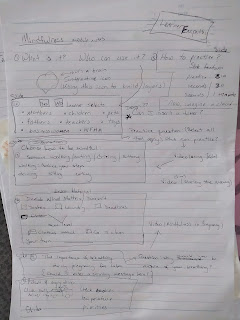Week 5 - Empathy
Topic: Mindfulness
Target audience: Everyone? Can I focus on people who self-identify as overwhelmed with life and managing the several areas it involves?
Mothers
How to gather data? Informal survey through messaging. Poll people I know about their perspective of mindfulness.
Question: How do you define/understand "mindfulness"?
Design Methods
- Persona
- Because we naturally relate to other people
- People typically share similar interests and lifestyles that influence their attraction to a product
- Without a persona, designers/design team make assumptions or design for themselves - Problematic!
- Gives a target to focus on
- User journey mapping
- Visualize the steps a user will take to accomplish a goal
- 1st: Whose journey is it? Using the data collected about users' characteristics, what do I want them to accomplish?
- 2nd: Plot the stages of the experience using a timeline
- Identify the 6 aspects: Stages, Activities, Thoughts and Emotions, Touchpoints, Pains, Gains... as well as the levels of progression
- Ex
- Key elements: Actor (persona/POV) | Scenario/Expectations (scenario can be actual or anticipated) | Journey Phases | Actions/Mindsets/Emotions | Opportunities
- NN Group Journey Phases ex: For an ecommerce scenario (like buying Bluetooth speakers), the stages can be discover, try, buy, use, seek support.
- Actions/Mindsets/Emotions: Actions = actual behaviors and steps. Mindset = thoughts, questions, and information needed during each stage. Emotions = ups and downs of experience (delights versus frustrations)
- Opportunities give designers feedback. What needs to be done? What needs to change? How?
- Scenarios
- Storytelling (my favorite?)
- Use the persona developed. Imagine the user interacts with my module.
- Who are they? What do they care about? Why might they need to use your module?
- List features that the module will demonstrate.
- Structure the story. Narrate the story. Then, what 3 qualities from my design concept emerge from the story?
- Empathy mapping
- Used in UX to depict who an end user is and their experience
- Benefit: 1) create shared understanding, 2) make decisions
- 4 quadrants: Says / Thinks / Does / Feels
- First step: Identify the persona that will be mapped
- Step 1: Define scope and goals (who is the user, what task do they accomplish)
- Step 2: Gather materials to make the map (poster/post-its, etc.)
- Step 3: Collect research (interview/ observation/ contextual info)
- Step 4: Analyze the findings and generate Says/Thinks/Does/Feels
- Step 5: Converge and cluster for similar ideas and name the themes
- Result: Shared visualization
- Quickest and easiest method?



Comments
Post a Comment